Page 335 of 446
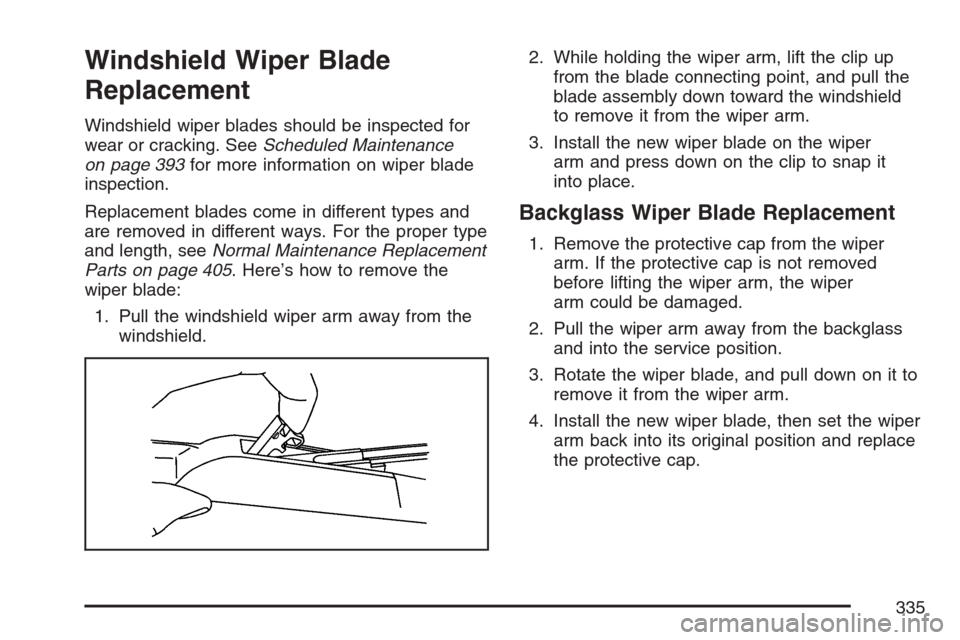
Windshield Wiper Blade
Replacement
Windshield wiper blades should be inspected for
wear or cracking. SeeScheduled Maintenance
on page 393for more information on wiper blade
inspection.
Replacement blades come in different types and
are removed in different ways. For the proper type
and length, seeNormal Maintenance Replacement
Parts on page 405. Here’s how to remove the
wiper blade:
1. Pull the windshield wiper arm away from the
windshield.2. While holding the wiper arm, lift the clip up
from the blade connecting point, and pull the
blade assembly down toward the windshield
to remove it from the wiper arm.
3. Install the new wiper blade on the wiper
arm and press down on the clip to snap it
into place.
Backglass Wiper Blade Replacement
1. Remove the protective cap from the wiper
arm. If the protective cap is not removed
before lifting the wiper arm, the wiper
arm could be damaged.
2. Pull the wiper arm away from the backglass
and into the service position.
3. Rotate the wiper blade, and pull down on it to
remove it from the wiper arm.
4. Install the new wiper blade, then set the wiper
arm back into its original position and replace
the protective cap.
335
Page 336 of 446
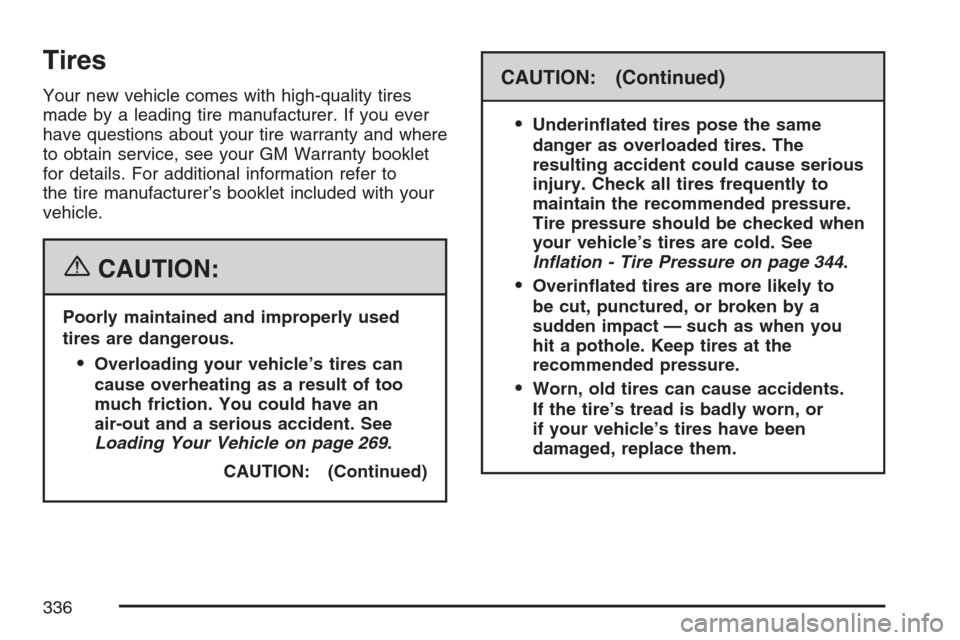
Tires
Your new vehicle comes with high-quality tires
made by a leading tire manufacturer. If you ever
have questions about your tire warranty and where
to obtain service, see your GM Warranty booklet
for details. For additional information refer to
the tire manufacturer’s booklet included with your
vehicle.
{CAUTION:
Poorly maintained and improperly used
tires are dangerous.
Overloading your vehicle’s tires can
cause overheating as a result of too
much friction. You could have an
air-out and a serious accident. See
Loading Your Vehicle on page 269.
CAUTION: (Continued)
CAUTION: (Continued)
Underin�ated tires pose the same
danger as overloaded tires. The
resulting accident could cause serious
injury. Check all tires frequently to
maintain the recommended pressure.
Tire pressure should be checked when
your vehicle’s tires are cold. See
Inflation - Tire Pressure on page 344.
Overin�ated tires are more likely to
be cut, punctured, or broken by a
sudden impact — such as when you
hit a pothole. Keep tires at the
recommended pressure.
Worn, old tires can cause accidents.
If the tire’s tread is badly worn, or
if your vehicle’s tires have been
damaged, replace them.
336
Page 337 of 446
Tire Sidewall Labeling
Useful information about a tire is molded into its
sidewall. The examples below show a typical
passenger vehicle tire and a compact spare tire
sidewall.(A) Tire Size:The tire size is a combination of
letters and numbers used to de�ne a particular
tire’s width, height, aspect ratio, construction type,
and service description. See the “Tire Size”
illustration later in this section for more detail.
(B) TPC Spec (Tire Performance Criteria
Speci�cation):Original equipment tires designed
to GM’s speci�c tire performance criteria have
a TPC speci�cation code molded onto the sidewall.
GM’s TPC speci�cations meet or exceed all
federal safety guidelines.
(C) DOT (Department of Transportation):
The Department of Transportation (DOT) code
indicates that the tire is in compliance with the
U.S. Department of Transportation Motor Vehicle
Safety Standards.
Passenger (P-Metric) Tire Example
337
Page 339 of 446
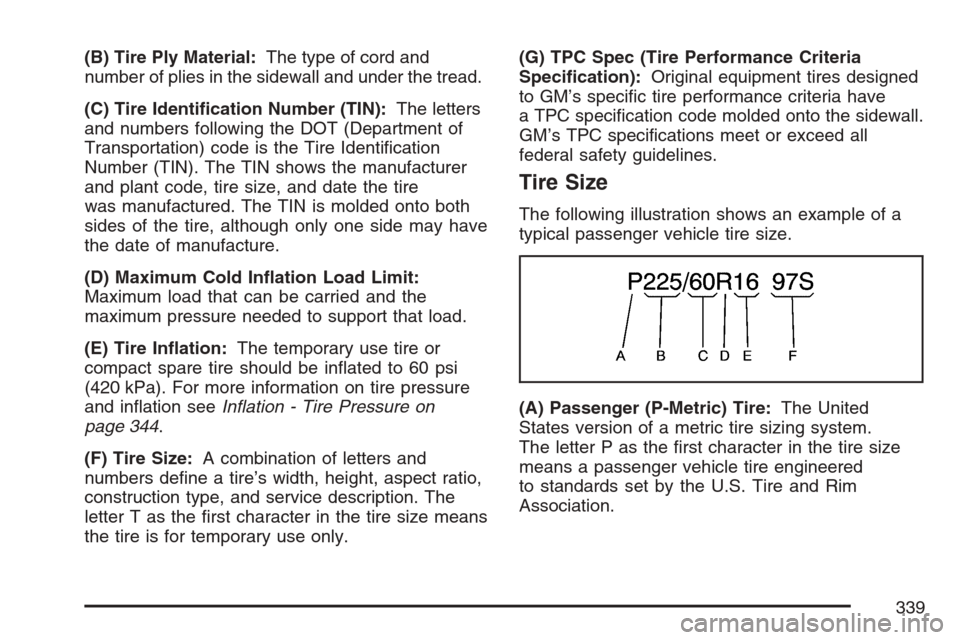
(B) Tire Ply Material:The type of cord and
number of plies in the sidewall and under the tread.
(C) Tire Identi�cation Number (TIN):The letters
and numbers following the DOT (Department of
Transportation) code is the Tire Identi�cation
Number (TIN). The TIN shows the manufacturer
and plant code, tire size, and date the tire
was manufactured. The TIN is molded onto both
sides of the tire, although only one side may have
the date of manufacture.
(D) Maximum Cold In�ation Load Limit:
Maximum load that can be carried and the
maximum pressure needed to support that load.
(E) Tire In�ation:The temporary use tire or
compact spare tire should be in�ated to 60 psi
(420 kPa). For more information on tire pressure
and in�ation seeInflation - Tire Pressure on
page 344.
(F) Tire Size:A combination of letters and
numbers de�ne a tire’s width, height, aspect ratio,
construction type, and service description. The
letter T as the �rst character in the tire size means
the tire is for temporary use only.(G) TPC Spec (Tire Performance Criteria
Speci�cation):Original equipment tires designed
to GM’s speci�c tire performance criteria have
a TPC speci�cation code molded onto the sidewall.
GM’s TPC speci�cations meet or exceed all
federal safety guidelines.
Tire Size
The following illustration shows an example of a
typical passenger vehicle tire size.
(A) Passenger (P-Metric) Tire:The United
States version of a metric tire sizing system.
The letter P as the �rst character in the tire size
means a passenger vehicle tire engineered
to standards set by the U.S. Tire and Rim
Association.
339
Page 340 of 446
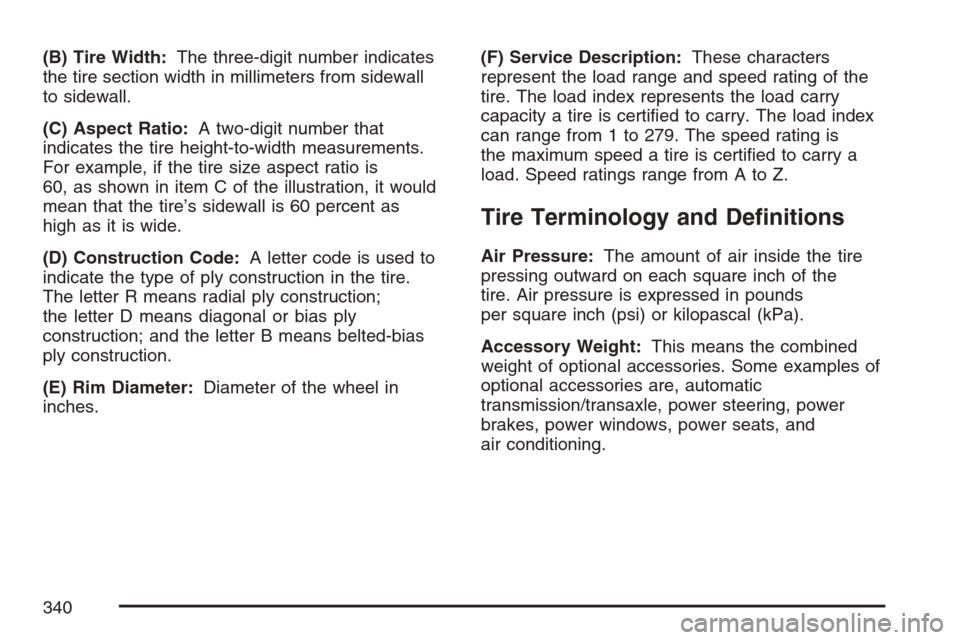
(B) Tire Width:The three-digit number indicates
the tire section width in millimeters from sidewall
to sidewall.
(C) Aspect Ratio:A two-digit number that
indicates the tire height-to-width measurements.
For example, if the tire size aspect ratio is
60, as shown in item C of the illustration, it would
mean that the tire’s sidewall is 60 percent as
high as it is wide.
(D) Construction Code:A letter code is used to
indicate the type of ply construction in the tire.
The letter R means radial ply construction;
the letter D means diagonal or bias ply
construction; and the letter B means belted-bias
ply construction.
(E) Rim Diameter:Diameter of the wheel in
inches.(F) Service Description:These characters
represent the load range and speed rating of the
tire. The load index represents the load carry
capacity a tire is certi�ed to carry. The load index
can range from 1 to 279. The speed rating is
the maximum speed a tire is certi�ed to carry a
load. Speed ratings range from A to Z.
Tire Terminology and De�nitions
Air Pressure:The amount of air inside the tire
pressing outward on each square inch of the
tire. Air pressure is expressed in pounds
per square inch (psi) or kilopascal (kPa).
Accessory Weight:This means the combined
weight of optional accessories. Some examples of
optional accessories are, automatic
transmission/transaxle, power steering, power
brakes, power windows, power seats, and
air conditioning.
340
Page 350 of 446
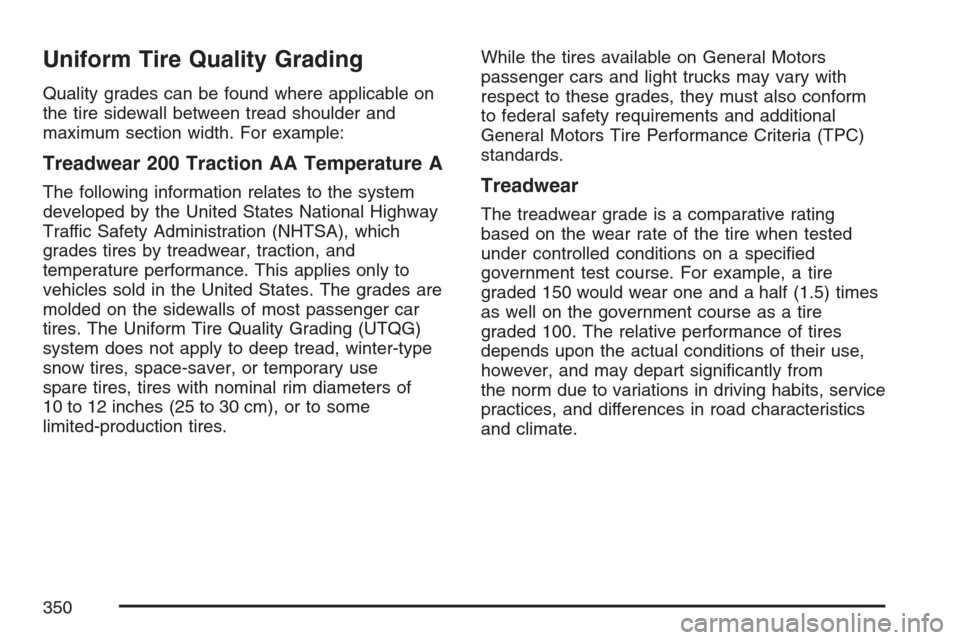
Uniform Tire Quality Grading
Quality grades can be found where applicable on
the tire sidewall between tread shoulder and
maximum section width. For example:
Treadwear 200 Traction AA Temperature A
The following information relates to the system
developed by the United States National Highway
Traffic Safety Administration (NHTSA), which
grades tires by treadwear, traction, and
temperature performance. This applies only to
vehicles sold in the United States. The grades are
molded on the sidewalls of most passenger car
tires. The Uniform Tire Quality Grading (UTQG)
system does not apply to deep tread, winter-type
snow tires, space-saver, or temporary use
spare tires, tires with nominal rim diameters of
10 to 12 inches (25 to 30 cm), or to some
limited-production tires.While the tires available on General Motors
passenger cars and light trucks may vary with
respect to these grades, they must also conform
to federal safety requirements and additional
General Motors Tire Performance Criteria (TPC)
standards.Treadwear
The treadwear grade is a comparative rating
based on the wear rate of the tire when tested
under controlled conditions on a speci�ed
government test course. For example, a tire
graded 150 would wear one and a half (1.5) times
as well on the government course as a tire
graded 100. The relative performance of tires
depends upon the actual conditions of their use,
however, and may depart signi�cantly from
the norm due to variations in driving habits, service
practices, and differences in road characteristics
and climate.
350
Page 379 of 446
Vehicle Identi�cation
Vehicle Identi�cation Number (VIN)
This is the legal identi�er for your vehicle. It
appears on a plate in the front corner of the
instrument panel, on the driver’s side. You can see
it if you look through the windshield from outside
your vehicle. The VIN also appears on the Vehicle
Certi�cation and Service Parts labels and the
certi�cates of title and registration.
Engine Identi�cation
The eighth character in the VIN is the engine
code. This code will help you identify your vehicle’s
engine, speci�cations, and replacement parts.
Service Parts Identi�cation Label
You will �nd this label on the inside of the glove
box. It is very helpful if you ever need to order
parts. On this label, you will �nd the following:
VIN
Model designation
Paint information
Production options and special equipment
Do not remove this label from the vehicle.
379
Page 389 of 446
Maintenance Schedule................................ 390
Introduction............................................... 390
Maintenance Requirements........................ 390
Your Vehicle and the Environment............ 391
Using the Maintenance Schedule............... 391
Scheduled Maintenance............................. 393
Additional Required Services..................... 396
Maintenance Footnotes.............................. 397Owner Checks and Services..................... 398
At Each Fuel Fill....................................... 399
At Least Once a Month............................. 399
At Least Once a Year............................... 400
Recommended Fluids and Lubricants........ 403
Normal Maintenance Replacement Parts..... 405
Engine Drive Belt Routing......................... 406
Maintenance Record.................................. 407
Section 6 Maintenance Schedule
389